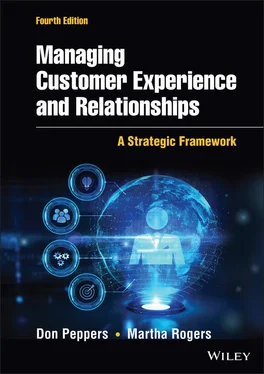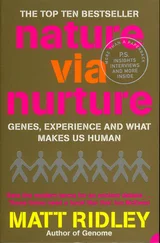The goal of this book is not just to acquaint the reader with the techniques of managing customer experiencesand relationships. The more ambitious goal of this book is to help the reader understand the essence of customer strategy and how to apply it to the task of managing a successful enterprise in the 21st century.
This relatively new task that enterprises are now taking on, treating different customers differently, goes by a number of different labels and buzzwords. Some refer to it as “ customer centricity” or “customer engagement.” Others may refer to it as “customer management” or “ customer focus.” But no matter what term is used, the central premise is that an enterprise should seek to engage its customers, one at a time, in long-lasting, mutuallyvaluable relationships, based on trust.
Moreover, to do this successfully, an enterprise must be able to see itself through a customer's own eyes. It must learn how to experience what each different customer experiences, and then take steps to ensure that this experience becomes better, easier, more convenient, and even more enjoyable for the customer, over the lifetime of that customer's relationship with the business. And businesses do this because their managers understand, intuitively, that when a customer has a better experience, the business will be creating more value , which means that the relationship with this customer now has a higher likelihood of increased profitability.
The dynamics of the customer-enterprise relationship have changed dramatically over time. Customers have always been at the heart of an enterprise's long-term growth strategies, marketing and sales efforts, product development, labor and resource allocation, and overall profitability directives. Historically, enterprises have encouraged the active participation of a sampling of customers in the research and development of their products and services.
But until recently, enterprises have been structured and managed around the products and services they create and sell. Driven by assembly-line technology, mass media, and mass distribution, which appeared at the beginning of the twentieth century, the Industrial Age was dominated by businesses that sought to mass-produce products and to gain a competitive advantage by manufacturing a product that was perceived by most customers as better than its closest competitor. Product innovation, therefore, was the important key to business success. To increase its overall market share, the twentieth-century enterprise would use mass marketingand mass advertising to reach the greatest number of potential customers.
As a result, most twentieth-century products and services eventually became highly commoditized. Branding emerged to offset this perception of being like all the other competitors; in fact, branding from its beginning was, in a way, an expensive substitute for relationships companies could not have with their newly blossomed masses of customers. Facilitated by lots and lots of mass-media advertising, brands have helped add value through familiarity, image, and trust. Historically, brands have played a critical role in helping customers distinguish what they deem to be the best products and services. A primary enterprise goal has been to improve brand awareness of products and services and to increase brand preference and brand loyalty among consumers. For many consumers, a brand name has traditionally testified to the trustworthiness or quality of a product or service. Today, though, more and more, customers say they value brands, but their opinions are based on their “relationship with the brand.” As a result, brand reputation is becoming one and the same with customers' experience with the brand, product, or company (including relationships). 1 Indeed, consumers are often content as long as they can buy one brand of a consumer packaged good that they know and respect.
The two-way brand, or branded relationship, transforms itself based on the ongoing dialogue between the enterprise and the customer. The branded relationship is “aware” of the customer (giving new meaning to the term brand awareness ).
For many years, enterprises depended on gaining the competitive advantage from the best brands. Brands have been untouchable, immutable, and inflexible parts of the twentieth-century mass-marketing era. But in the interactive era of the 21st century, firms are instead strategizing how to gain sustainable competitive advantage from the information they gather about customers. As a result, enterprises are creating a two-way brand, one that thrives on customer information and interaction. The two-way brand, or branded relationship, transforms itself based on the ongoing dialogue between the enterprise and the customer. The branded relationship is “aware” of the customer (giving new meaning to the term brand awareness ) and constantly changes to suit the needs of that particular individual. In current discussions, the focus is on ways to redefine the brand reputation as more customer oriented, using phrases such as “brand engagement with customer,” “brand relationship with customer,” and the customer's “brand experience.” Add to this the transparency for brands and rampant ratings for products initiated by social media, and it's clear why companies are realizing that what customers say about them is more important than what the companies say about themselves.
Companies are realizing that what customers say about them is more important than what the companies say about themselves.
What does it mean for an enterprise to focus on its customers as the key to competitive advantage? It means creating new shareholder value by deliberately preserving and growing the value of the customer base.
ROOTS OF CUSTOMER RELATIONSHIPS AND EXPERIENCE
Once you strip away all the activities that keep everybody busy every day, the goal of every enterprise is simply to get, keep, and grow customers (whether those are business-to-consumer [B2C]customers or enterprise business customers [B2B]). This is true for nonprofits (where the “customers” may be donors or volunteers) as well as for-profits, for small businesses as well as large, for public as well as private enterprises. It is true for hospitals, governments, universities, and other institutions as well. What does it mean for an enterprise to focus on its customers as the key to competitive advantage? Obviously, it does not mean giving up whatever product edge or operational efficiencies might have provided an advantage in the past. It does mean using new strategies, nearly always requiring new technologies, to focus on growing the value of the company by deliberately and strategically growing the value of the customer base.
To some executives, customer relationship management (CRM)is a technology or software solution that helps track data and information about customers to enable better customer service. Others think of CRM, or one-to-one, as an elaborate marketing or customer service discipline. We even recently heard CRM described as “personalized email.” But it's far more than that.
Managing customer relationships is what companies do to optimize the value of each customer, because they understand the customer's perspective and what it is—and should be—like to be a customer. This book is about much more than setting up a business website or redirecting some of the mass-media budget into the call-center database or cloud analytics or social networking.It's about increasing the value of the company through specific customer strategies (see Exhibit 1.1).
Читать дальше












